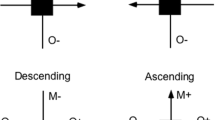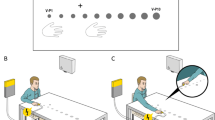Abstract
Numerous studies have found that the near space immediately surrounding the body is represented differently than more distant space. In a previous study, we found a gradual shift in attentional bias (on a line bisection task) between near and far space (Longo and Lourenco in Neuropsychologia 44:977–981, 2006). The present study concerns the possibility that arm length relates systematically to the rate at which this gradual shift between near and far space occurs. Participants bisected lines using a laser pointer at eight distances (within and beyond arm’s reach), and the rate of shift was estimated by the slope of the least-squares regression line. A negative correlation was found between the slopes and arm length; participants with longer arms showed a more gradual shift in bias with increasing distance than those with shorter arms. These results suggest that, while near space cannot be considered categorically as that within arm’s reach, there is a systematic relation between the extent (“size”) of near space and arm length. Arm length may constitute an intrinsic metric for the representation of near space.


Similar content being viewed by others
Notes
Some authors (e.g., Mesulam 1981) have suggested, in contrast, that while both hemispheres direct attention primarily contralaterally, the right hemisphere has an additional (weaker) tendency to direct attention ipsilaterally. Since the vector sum of the right hemisphere’s contra- and ipsilateral orienting tendencies yield a leftward tendency weaker than the rightward orienting tendency of the left hemisphere, the two theories make identical behavioral predictions.
Height was measured both with and without shoes. As these measures were almost perfectly correlated, r(22) = 0.995, P < 0.0001, only height without shoes was used in analyses.
References
Berti A, Smania N, Rabuffetti M, Ferrarin M, Spinazzola L, D’Amico A et al (2002) Coding of far and near space during walking in neglect patients. Neuropsychology 16:390–399
Bjoertomt O, Cowey A, Walsh V (2002) Spatial neglect in near and far space investigated by repetitive transcranial magnetic stimulation. Brain 125:2012–2022
Brain WR (1941) Visual disorientation with special reference to lesions of the right cerebral hemisphere. Brain 64:244–272
Corbetta M, Shulman GL, Miezin FM, Petersen SE (1995) Superior parietal cortex activation during spatial attention shifts and visual feature conjunction. Science 270:802–805
Cowey A, Small M, Ellis S (1999) No abrupt change in visual hemineglect from near to far space. Neuropsychologia 37:1–6
Cutting JE, Vishton PM (1995) Perceiving layout and knowing distances: the integration, relative potency, and contextual use of different information about depth. In: Epstein W, Rogers SJ (eds) Perception of space and motion. Academic, San Diego, pp 69–117
Fierro B, Brighina F, Oliveri M, Piazza A, La Bua V, Buffa D et al (2000) Contralateral neglect induced by right posterior parietal rTMS in healthy subjects. Neuroreport 11:1519–1521
Gibson JJ (1979) The ecological approach to visual perception. Houghton Mifflin, Boston
Hall ET (1966) The hidden dimension. Doubleday & Co, Garden City
Halligan PW, Fink GR, Marshall JC, Vallar G (2003) Spatial cognition: evidence from visual neglect. Trends Cogn Sci 7:125–133
Jewell G, McCourt ME (2000) Pseudoneglect: a review and meta-analysis of performance factors in line bisection tasks. Neuropsychologia 38:93–110
Kinsbourne M (1987) Mechanisms of unilateral neglect. In: Jeannerod M (ed) Neurophysiological and neuropsychological aspects of spatial neglect. Elsevier, Amsterdam, pp 69–86
Làdavas E, Del Pesce M, Provinciali L (1989) Unilateral attention deficits and hemispheric asymmetries in the control of visual attention. Neuropsychologia 27:353–366
Longo MR, Lourenco SF (2006) On the nature of near space: effects of tool use and the transition to far space. Neuropsychologia 44:977–981
Maravita A, Iriki A (2004) Tools for the body (schema). Trends Cogn Sci 8:79–86
Mark LS (1987) Eyeheight-scaled information about affordances: a study of sitting and stair climbing. J Exp Psychol Hum Percept Perform 13:361–370
McMahon TA, Bonner JT (1983) On size and life. Scientific American Library, New York
Mesulam MM (1981) A cortical network for directed attention and unilateral neglect. Ann Neurol 10:309–325
Nicholson E (1912) Men and measures: a history of weights and measures ancient and modern. Smith, Elder & Co, London
Oldfield RC (1971) The assessment and analysis of handedness: the Edinburgh inventory. Neuropsychologia 9:97–113
Previc FH (1998) The neuropsychology of 3-D space. Psychol Bull 124:123–164
Ritchie-Calder L (1970) Conversion to the metric system. Sci Am 223(1):17–25
Rizzolatti G, Scandolara C, Matelli M, Gentilucci M (1981) Afferent properties of periarcuate neurons in macaque monkeys. II. Visual properties. Behav Brain Res 2:147–163
Schmidt-Nielsen K (1984) Scaling: why is animal size so important? Cambridge University Press, Cambridge
Sommer R (1969) Personal space: the behavioral basis of design. Prentice-Hall, Englewood Cliffs
Varnava A, McCarthy M, Beaumont JG (2002) Line bisection in normal adults: direction of attentional bias for near and far space. Neuropsychologia 40:1372–1378
Warren WH (1984) Perceiving affordances: visual guidance of stair climbing. J Exp Psychol Hum Percept Perform 10:683–703
Warren WH, Whang S (1987) Visual guidance of walking through apertures: body-scaled information for affordances. J Exp Psychol Hum Percept Perform 13:371–383
Witt JK, Proffitt DR, Epstein W (2005) Tool use affects perceived distance, but only when you intend to use it. J Exp Psychol Hum Percept Perform 31:880–888
Acknowledgments
We thank the Travel and Research Committee of the Psychology Graduate Students’ Organization at the University of Chicago for funding, Bennett Bertenthal and Janellen Huttenlocher for support and discussion, and Nicholas Holmes for helpful comments.
Author information
Authors and Affiliations
Corresponding author
Rights and permissions
About this article
Cite this article
Longo, M.R., Lourenco, S.F. Space perception and body morphology: extent of near space scales with arm length. Exp Brain Res 177, 285–290 (2007). https://doi.org/10.1007/s00221-007-0855-x
Received:
Accepted:
Published:
Issue Date:
DOI: https://doi.org/10.1007/s00221-007-0855-x




